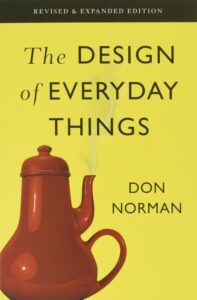
The Design of Everyday Things by Don Norman (Book Summery)
- Techriv
- March 7, 2024
- Entrepreneurship
- 0 Comments
Introduction:
“The Design of Everyday Things” by Don Norman delves into the intricate relationship between design, psychology, and usability, offering a blueprint for creating products that seamlessly integrate into our lives. Norman introduces the concept of “affordances,” emphasizing the importance of clear and intuitive design to reduce cognitive load on users. He explores the construction of “mental models” and advocates for aligning design with users’ perceptions to create products that feel natural and intuitive. Moreover, Norman addresses human error, advocating for error-tolerant systems and incorporating safeguards to enhance user satisfaction. At its core, Norman’s philosophy champions a human-centered approach to design, empowering designers to empathize with users’ needs and solve complex problems while enriching their experiences.
Download 500+ Customizable Business Templates:
Download now
The Psychopathology of Everyday Things
In this foundational chapter, Norman introduces the concept of “affordances,” which are the possibilities for action offered by objects or environments. He argues that good design should make these affordances clear and intuitive, helping users understand how to interact with products effortlessly. He also discusses the importance of feedback in design, emphasizing the need for systems to provide clear and immediate responses to user actions.
The Psychology of Everyday Actions
Norman delves into the cognitive processes involved in everyday actions, highlighting how people perceive, interpret, and execute tasks. He introduces the concept of “mental models,” which are the internal representations individuals construct to understand how things work. Designers must align their products with users’ mental models to ensure usability and prevent errors.
Knowledge in the Head and in the World
In this chapter, Norman explores the interplay between internal knowledge (stored in the mind) and external knowledge (available in the environment). He argues that good design should offload cognitive burden by leveraging external cues and resources, such as clear signage or intuitive interfaces, to support users’ tasks and decision-making processes.
Knowing What to Do
Norman discusses the challenges users face when trying to determine the appropriate actions to accomplish their goals. He emphasizes the importance of providing clear, visible, and understandable cues that guide users’ behavior and help them navigate complex systems. Designers must anticipate users’ needs and intentions to create intuitive interfaces that facilitate smooth interactions.
To Err Is Human
In this chapter, Norman examines human error and its implications for design. He distinguishes between slips (actions not intended by the user) and mistakes (errors in goal formulation or execution) and discusses strategies for designing error-tolerant systems. By understanding the root causes of errors, designers can implement safeguards and affordances to mitigate their impact and enhance user experience.
The Design Challenge
Norman presents a framework for tackling design challenges, emphasizing the importance of understanding users’ needs, goals, and constraints. He advocates for a human-centered approach that involves iterative prototyping, user testing, and feedback to refine designs. By prioritizing usability and user satisfaction, designers can create products that meet real-world demands and improve people’s lives.
Design Thinking
In the final chapter, Norman explores the principles of design thinking and their application in solving complex problems. He encourages designers to adopt a multidisciplinary approach, drawing insights from fields such as psychology, anthropology, and engineering. By embracing creativity, empathy, and iteration, designers can address diverse user needs and create innovative solutions that resonate with people’s experiences.
Download 500+ Customizable Business Templates:
Download now
Quotes from The Design of Everyday Things:
-
“Good design is actually a lot harder to notice than poor design, in part because good designs fit our needs so well that the design is invisible, serving us without drawing attention to itself.”
-
“To design is to devise courses of action aimed at changing existing situations into preferred ones.”
-
“The design is really an act of communication, which means having a deep understanding of the person with whom the designer is communicating.”
-
“Simplicity is not the goal. It is the by-product of a good idea and modest expectations.”
-
“Failures of design are failures of understanding, and they always mean that there are lessons to be learned. These are lessons that have implications for the future, and they should not be ignored.”
Real-Life Examples:
-
Door Handles: Norman discusses the importance of affordances, where objects suggest their function. A well-designed door handle provides a clear affordance – a horizontal bar suggests pulling, while a vertical handle suggests pushing. However, poorly designed handles, such as those without clear indications of how to operate them, often lead to user frustration and errors.
-
Google Search Engine: Google’s search engine embodies Norman’s emphasis on simplicity and feedback. The minimalist homepage and straightforward search bar convey a clear affordance, making it easy for users to understand its purpose and how to use it. Additionally, Google’s autocomplete feature and instant search results provide immediate feedback, guiding users’ interactions and reducing the cognitive effort required to find information.
-
IKEA Furniture: IKEA’s flat-pack furniture exemplifies Norman’s concept of understanding users’ needs and constraints. By providing clear assembly instructions and standardized components, IKEA enables users to easily construct furniture without specialized tools or skills. Furthermore, IKEA’s modular design approach allows users to customize and adapt furniture to fit their specific preferences and spatial constraints.
-
Tesla Model S: The Tesla Model S showcases Norman’s principles of error tolerance and feedback. The car’s autopilot feature uses sensors and algorithms to assist drivers with tasks such as lane-keeping and adaptive cruise control, reducing the likelihood of errors and accidents. Additionally, the car’s interface provides clear visual and auditory feedback to users, informing them of the car’s status and potential hazards, thus enhancing safety and usability.
The Design of Everyday Things Book Summery:
The Design of Everyday Things by Don Norman explores the principles of design and usability, emphasizing concepts like affordances, signifiers, and feedback to create intuitive and user-friendly products. Norman highlights the importance of clear communication between users and objects, advocating for designs that align with users’ mental models and cultural backgrounds while incorporating constraints and error handling to enhance usability. With practical insights and examples, the book serves as a guide for designers to create products that seamlessly integrate into users’ lives, ultimately aiming to improve the overall user experience in everyday interactions.
Conclusion:
“The Design of Everyday Things” offers valuable insights into the principles of user-centered design and the psychology of human-computer interaction. By understanding users’ behaviors, mental models, and needs, designers can create products that are intuitive, efficient, and enjoyable to use. Norman’s book serves as a roadmap for unlocking everyday genius and harnessing the power of design to enhance people’s lives.
“The Design of Everyday Things by Don Norman”

© You Exec

© Wikipedia (jordanfischer)
Download 500+ Customizable Business Templates:
Download now

